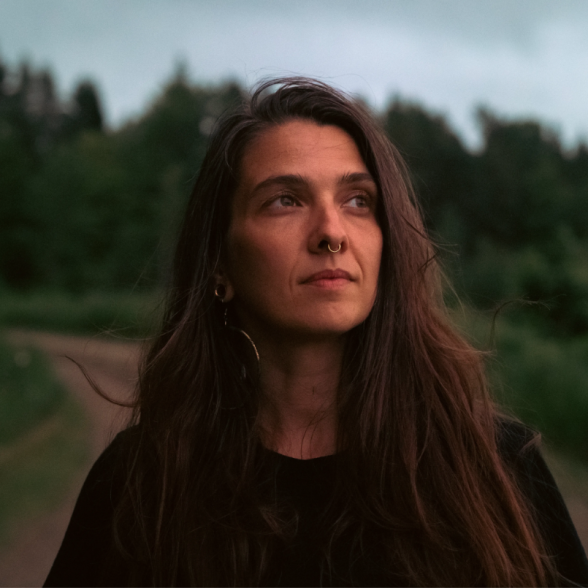On Thursday 12, I sat down with artist-in-residence for the Indigenous Studies and Community Engagement Initiative (ISCEI) Soleil Launière, to discuss her upcoming performance. According to her website, Launière is a Pekuakamilnu multidisciplinary artist who draws inspiration from a variety of art forms, including dance, body art, directing, and music. Audiovisual experimentation, the two-spirit body, and Innu cosmogony feature prominently in her work as well. Launière won the 28th annual Francouvertes music festival this spring – the first Indigenous artist to do so. On behalf of The McGill Daily, I asked Launière about what inspires her to create as a multimedia artist.
The following interview has been shortened and edited for clarity.
Eliana Freelund for The McGill Daily (MD): Could you introduce yourself to our readers? What kind of art do you like to create? What inspires you about a multimedia approach?
Soleil Launière (SL): My name is Soleil Launière and I’m a multidisciplinary artist. I’m always traveling (verser) between forms of art. For me, doing that is a form of decolonization – in the sense that prior to colonization the arts were not usually separated into distinct forms. Music was not only music, theatre was not only theatre. We mixed forms of art. It was ritualistic.
It was all part of the culture to mix those forms of art, and for me, that’s what I like to do the most. When I enter a space of creation I find that it’s like performing rituals – different forms of rituals, whether they be healing rituals or something else – that I usually need to live. I prefer to do art this way, to mix art forms. It’s a part of me, it’s a part of my culture.
MD: Would you say that this ritualistic approach gets rid of the idea of an endpoint? Do you think of your art as something cyclical?
SL: My art is always moving, it’s always cyclical. I don’t ever want to conform to one way or another. I believe there’s no certain way of doing things.
MD: Is there anything in particular that inspires you to create? Do you notice any recurring themes in your art?
SL: Oh, there’s a lot. Recently my work has been surrounding multi-generational subjects. I like to centre my art around the Earth as well. Nature is vast – it’s always a part of what I do.
Because I gave birth not that long ago, I think that that’s also a subject that’s really close to me – that really inspires me. I’ve been digging deep into the subject of childbirth and trying to see what it means to me, how it lives in my body, but also how it reflects on society. I like the idea of a subject that travels from one form into another.
Right now I’m really stuck on water as a theme. Water is part of the birth journey – it’s also a part of the healing journey. I feel I need something softer, more healing these days. My subjects were a lot harsher previously. I did a lot of performances about multi-generational trauma and things like that, but now I feel like I want to talk more about multi-generational healing. What my grandparents have passed on to me is not only their trauma, but also their healing. I want to focus my work on that idea more.
MD: Could you tell us a bit about your performance today? What is the significance of the water imagery? How are you choosing to represent it?
SL: Water speaks to me a lot because of the healing parts of it, how it connects to everything. It’s tied to life itself, just like all the elements. We wouldn’t live without them. Water, especially clean water, is extremely important in our lives.
I think that’s with everything that’s been happening in the world, I wasn’t sure how I wanted to approach this performance. There’s so much frustration, because of course there’s frustration, but I didn’t feel like being in that, or playing that role. I’m tired of being frustrated. I wanted to heal. I wanted to clean. I wanted to bring something cleansing to this space, and to myself as well. I felt like that was needed.
I went for something that obviously represents what’s happening, but uses a different approach. I use a soundscape in my performance that includes the sounds of protests. I also have the voice of my child playing in the background, representing a kind of complicated freedom. Although she’s an Indigenous woman, and history has not made it easy for her, she’s here and she lives.
I’m also going to put a white sheet up and continue to water it throughout the performance, as I water plants, as a way of symbolically keeping the dead alive.
MD: How can we learn more about you? Are there any upcoming performances we can look forward to?
SL: There are a lot of things coming up. I won Francouvertes this past spring, so musically there will be a lot happening in and around Montreal. There are shows coming up, as well as a tour, which will be a mix of performance art and music. You can check out the dates on Nikamowin, which is a really nice platform with Indigenous musicians. I also have a show in October with my baby in it. It’s a performance art piece that will be performed with three generations together.

